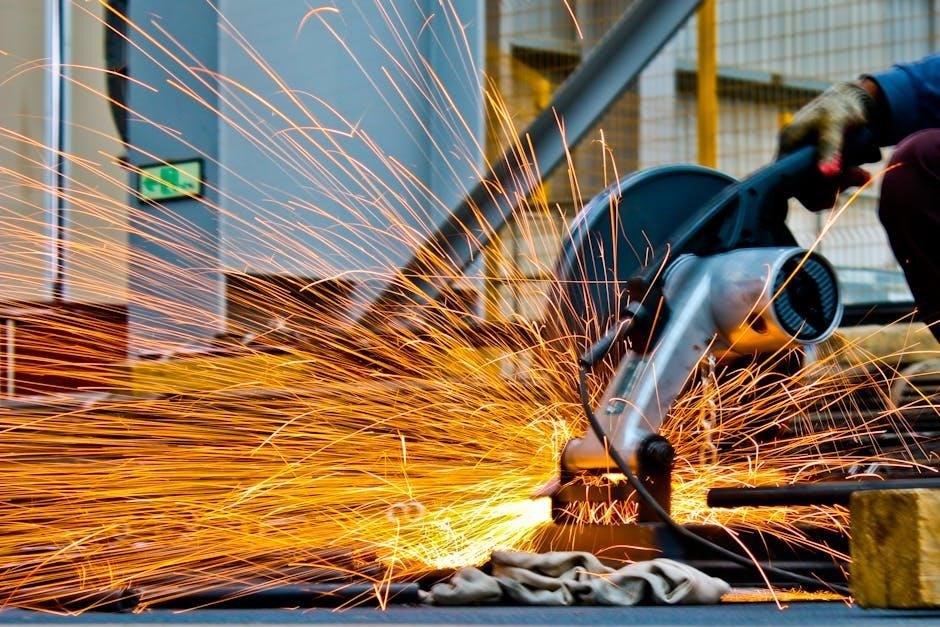The Hitachi WJ200 Series Inverter is a high-performance motor control solution, offering flexibility and reliability for industrial automation. This manual provides essential guidance for installation, operation, and safety.
1.1 Overview of the Hitachi WJ200 Series
The Hitachi WJ200 Series is a versatile and high-performance inverter designed for industrial automation applications. It offers single-phase and three-phase input options, covering a wide range of motor sizes from 1/8 HP to 20 HP. The series is available in 200V and 400V voltage classes, ensuring compatibility with various industrial systems. Known for its reliability and advanced control features, the WJ200 Series supports efficient motor operation and is suitable for diverse applications. This manual provides detailed guidance for proper installation, operation, and maintenance to maximize performance and safety.
1.2 Importance of the Instruction Manual
The instruction manual is essential for the safe and effective use of the Hitachi WJ200 Series Inverter. It provides detailed guidelines for installation, operation, and maintenance, ensuring optimal performance and compliance with safety standards. By following the manual, users can avoid potential hazards and guarantee proper functionality. The manual also includes troubleshooting tips and technical specifications, making it a critical resource for both novice and experienced operators. Always refer to the manual before starting any operation to ensure compliance and prevent accidents.

Key Features of the Hitachi WJ200 Inverter
The Hitachi WJ200 Inverter offers versatile design, supporting single-phase and three-phase inputs, with 200V and 400V voltage classes; It covers motor sizes from 1/8 HP to 20 HP, ensuring compatibility across various applications. Advanced features include customizable settings, optional expansion modules, and user-friendly operation, making it a robust solution for industrial and commercial needs.
2.1 Single-phase and Three-phase Input Options
The Hitachi WJ200 Series Inverter supports both single-phase and three-phase input options, offering flexibility for various applications. The single-phase input is available in the 200V class, while the three-phase input is offered in both 200V and 400V classes. This versatility allows the inverter to accommodate different power sources and motor requirements, ensuring compatibility with a wide range of industrial and commercial systems. The ability to handle multiple input types makes the WJ200 Series a versatile solution for diverse operational needs.
2.2 Voltage Class Variations (200V, 400V)
The Hitachi WJ200 Series Inverter is available in two primary voltage classes: 200V and 400V. The 200V class is ideal for standard industrial applications, while the 400V class is designed for higher-power requirements. These voltage options ensure compatibility with a wide range of motors and systems, providing flexibility for diverse operational needs. The WJ200 Series supports both single-phase and three-phase configurations within these voltage classes, making it adaptable to various power supply conditions. This versatility allows users to optimize performance across different applications.
2.3 Motor Size Coverage (1/8 HP to 20 HP)
The Hitachi WJ200 Series Inverter supports a wide range of motor sizes, from 1/8 HP to 20 HP, ensuring compatibility with various industrial applications. This extensive coverage allows users to optimize motor performance across different power requirements, from small-scale operations to heavy-duty machinery. The inverter’s flexibility in accommodating diverse motor sizes makes it a versatile solution for industries needing precise speed and torque control. This range ensures efficient operation, regardless of the application’s demands.

Technical Specifications of the WJ200 Series
The WJ200 Series offers single-phase and three-phase input options, with voltage classes of 200V and 400V. It supports motors from 1/8 HP to 20 HP, ensuring versatile performance across applications.
3.1 Input Voltage and Current Ratings
The Hitachi WJ200 Series supports single-phase and three-phase input configurations. For single-phase, the input voltage is 200VAC with a maximum current rating of 50A. Three-phase models offer 200VAC or 400VAC input options, with current ratings ranging from 10A to 50A depending on the model. Always ensure the input voltage matches the power supply and application requirements to maintain optimal performance and safety. Refer to the manual for specific current ratings corresponding to each voltage class and motor size.
3.2 Output Voltage and Frequency Range
The Hitachi WJ200 Series provides an output voltage range of 0-230V for single-phase models and 0-400V for three-phase models. The frequency range spans from 0 to 1000Hz, allowing precise speed control for various motor applications. This flexibility ensures compatibility with a wide range of industrial automation needs. Always refer to the manual for specific voltage and frequency ratings to ensure safe and optimal operation of the inverter in your application.
3.3 Compatible Motor Types and Applications
The Hitachi WJ200 Series supports a wide range of motor types, including standard induction motors and permanent magnet motors. It is designed to cover motor sizes from 1/8 HP to 20 HP, making it suitable for applications such as pumps, fans, conveyors, and industrial machinery. The inverter’s versatility ensures efficient operation across various industrial automation scenarios, providing precise speed and torque control for optimal performance. Always match the motor specifications with the inverter’s ratings for reliable operation.
Installation and Setup Guidelines
Proper installation ensures safe and efficient operation. Follow manual instructions for mounting, wiring, and grounding. Verify motor and power supply compatibility before startup.
4.1 Pre-installation Checks and Precautions
Before installing the Hitachi WJ200 inverter, ensure all safety guidelines are followed. Read the manual thoroughly and verify the product labels match your power source and application requirements. Check the motor size and voltage ratings to ensure compatibility. Disconnect power before starting installation to prevent accidents. Ensure the environment is well-ventilated and free from flammable materials. Proper grounding is essential for safe operation. Failure to follow these precautions may result in equipment damage or personal injury. Always prioritize safety and adherence to the manual’s instructions.
4.2 Mounting and Wiring Instructions
Mount the Hitachi WJ200 inverter securely using the provided brackets to ensure stable operation. Ensure proper grounding by connecting the grounding terminal to an earth connection. Wiring must be done with the correct cable sizes and types to prevent interference. Follow the manual’s torque specifications for terminal tightening to avoid damage. Keep wires organized and away from high-temperature areas. Refer to the provided diagrams for precise connection points. Proper wiring ensures safe and efficient operation, adhering to safety standards and preventing potential malfunctions.
4.3 Power Supply and Grounding Requirements
The Hitachi WJ200 Series requires a stable power supply matching its input ratings (200V or 400V class). Ensure the power source is clean and free from fluctuations. Proper grounding is essential for safe operation and noise reduction. Connect the grounding terminal to a reliable earth point. Use a class J or K fuse for overcurrent protection. Verify the power supply phase (single or three-phase) matches the inverter model. Consult the manual for specific voltage and frequency requirements to ensure optimal performance and compliance with safety standards.
Configuration and Parameter Settings
This section explains how to configure the inverter’s parameters for optimal performance. Adjust motor settings, speed, and torque to match your application needs, ensuring safe and efficient operation.
5.1 Understanding the Parameter List
The parameter list in the Hitachi WJ200 manual is essential for configuring the inverter. It details functions like motor tuning, speed settings, and torque control. Users can adjust parameters to optimize performance for specific applications. The list includes default values and customization options. Refer to the manual for a comprehensive guide on each parameter’s purpose and adjustment procedures, ensuring proper setup and operation.
5.2 Setting Up Motor Parameters
Setting up motor parameters is crucial for optimal inverter performance. Enter the motor’s rated voltage, current, and frequency as specified in the manual. Use the auto-tuning function to synchronize the inverter with the motor. Adjust parameters like acceleration/deceleration time and torque settings based on the application. Ensure all motor data matches the nameplate specifications for precise control. Refer to the parameter list for detailed guidance on configuring these settings effectively. Proper setup ensures efficient and safe operation of the motor-inverter system.
5.3 Configuring Speed and Torque Settings
Configuring speed and torque settings ensures precise motor control. Enter the motor’s rated speed and torque values from the nameplate into the inverter. Use the parameter list to adjust acceleration and deceleration times based on the application. Enable torque boost if required for heavy loads. Set the maximum and minimum frequency to match the motor’s operational range. Ensure all settings align with the motor’s specifications for optimal performance. Proper configuration enhances efficiency and prevents motor overload or damage. Refer to the manual for detailed instructions on fine-tuning these parameters effectively.

Operation and Control of the WJ200 Inverter
Efficient operation involves proper start/stop functions, real-time parameter monitoring, and adjusting settings for optimal performance. Use power management features and adhere to safety protocols.
6;1 Power Management and Start/Stop Functions
The Hitachi WJ200 inverter offers advanced power management features, enabling efficient control of motor operations. The start/stop functions are designed for smooth transitions, minimizing downtime and ensuring precision. Proper sequencing ensures motor protection during power-up and shutdown. Users can monitor and adjust power levels dynamically, optimizing performance while maintaining safety protocols. Refer to the manual for detailed procedures on configuring these functions to suit specific applications and ensure reliable operation. Always follow safety guidelines to prevent unexpected shutdowns or system malfunctions.
6.2 Monitoring and Adjusting Operational Parameters
The Hitachi WJ200 inverter allows real-time monitoring of operational parameters, ensuring precise control over motor performance. Users can adjust settings such as speed, torque, and frequency to optimize efficiency. The control panel provides easy access to key parameters, while advanced features enable fine-tuning for specific applications. Regular monitoring helps identify potential issues early, preventing downtime. Always refer to the manual for guidance on adjusting parameters safely and effectively to maintain optimal motor operation and system reliability.
6.3 Using the Remote Operator (Optional)
The Hitachi WJ200 inverter supports an optional remote operator for enhanced convenience. This feature allows users to monitor and adjust operational parameters from a distance. The remote operator enables easy access to speed, torque, and other settings without direct physical interaction with the inverter. It is ideal for applications where the inverter is installed in hard-to-reach locations. Always follow the manual’s instructions for proper setup and usage to ensure safe and effective operation of the remote control functionality.

Maintenance and Troubleshooting
Regular maintenance ensures optimal performance of the Hitachi WJ200 inverter. Monitor operational parameters, check for wear, and address common fault codes promptly. Refer to the manual for repair guidelines and troubleshooting steps to resolve issues efficiently.
7.1 Routine Maintenance Checks
Regular maintenance is crucial for ensuring the Hitachi WJ200 inverter operates efficiently. Check the cooling fan for dust buildup and ensure proper airflow. Verify all terminal connections are secure and free from corrosion. Inspect the power cables for signs of wear or damage. Clean the inverter’s exterior to prevent dust accumulation. Additionally, review the parameter settings to confirm they match your application requirements. Replace any worn or damaged components promptly to maintain performance and prevent unexpected downtime. Always refer to the manual for specific guidelines and safety precautions during maintenance activities.
7.2 Common Fault Codes and Solutions
This section outlines common fault codes for the Hitachi WJ200 inverter and their solutions. For example, fault code “OC” indicates an overcurrent condition, often caused by excessive load or short circuits. To resolve, disconnect the load, check for faults in the motor or wiring, and restart the inverter. Fault code “OV” signifies an overvoltage issue, which may result from improper power supply. Ensure the input voltage matches the inverter’s rating and verify the power source. Always consult the manual for detailed troubleshooting steps and safety precautions.
7.3 Repair and Replacement Guidelines
For repairs, ensure the inverter is powered off and discharged. Handle internal components carefully to avoid damage. Use authorized Hitachi replacement parts and follow the manual’s instructions. If a component fails, replace it with a compatible part and test the inverter afterward. Store unused parts in a cool, dry place, away from direct sunlight. For complex repairs, contact Hitachi’s service center. Always adhere to safety precautions and environmental guidelines when disposing of defective components.

Safety Precautions and Compliance
Adhere to safety guidelines for handling, storage, and emergency procedures. Ensure compliance with international standards for safe installation and operation of the Hitachi WJ200 inverter.
8.1 Handling and Storage Safety Tips
Proper handling and storage are crucial to maintain the integrity of the Hitachi WJ200 inverter. Avoid exposing the unit to physical stress, such as dropping or bending. Use suitable lifting equipment for transportation. Clean the inverter with a dry, soft cloth to prevent dust buildup. Store the device in a dry, cool environment, away from direct sunlight and corrosive chemicals. Ensure the area is free from excessive humidity and vibration. Keep the inverter in its original packaging or a protective case when not in use. Avoid stacking heavy objects on top of the unit to prevent damage. Always follow the manufacturer’s guidelines for handling and storage to ensure optimal performance and longevity of the device.
8.2 Emergency Procedures and Shutdown
In case of an emergency, immediately disconnect the power supply to the Hitachi WJ200 inverter. Activate the emergency stop button if available. Ensure all personnel are safely evacuated from the area. Avoid sudden shutdowns, as they may cause system instability. If a fault occurs, refer to the fault codes in the manual for troubleshooting. After resolving the issue, restart the inverter according to the manual’s reset procedure. Always prioritize safety and follow proper shutdown protocols to prevent damage to the device or injury to personnel.
8.3 Compliance with International Standards
The Hitachi WJ200 Series Inverter is designed to meet international safety and performance standards, ensuring reliability and compliance in global markets. It adheres to certifications such as UL, CE, and IEC, guaranteeing adherence to global safety and environmental regulations. This compliance ensures the inverter operates efficiently and safely in various industrial applications worldwide. By meeting these standards, the WJ200 Series demonstrates Hitachi’s commitment to delivering high-quality, globally compatible products for industrial automation needs.

Advanced Features and Customization
The Hitachi WJ200 Series offers customizable settings, optional expansion modules, and software upgrades for tailored performance. These features enhance flexibility and adaptability to specific industrial applications.
9.1 Customizing the Inverter for Specific Applications
The Hitachi WJ200 Series allows for advanced customization to meet specific application needs. Users can adjust motor parameters, configure speed and torque settings, and utilize optional accessories. This flexibility ensures optimal performance in diverse industrial environments. Customization options are accessed through the parameter list, enabling precise control over operational settings. Additionally, the inverter supports expansion modules for enhanced functionality. Proper customization requires a thorough understanding of the system and application requirements, as outlined in the manual, to ensure safe and efficient operation.
9.2 Using Optional Accessories and Expansion Modules
The Hitachi WJ200 Series supports optional accessories and expansion modules to enhance functionality. These include communication modules for remote monitoring, I/O expansion cards, and external operators. Accessories like the remote operator allow for convenient control and monitoring of the inverter. Expansion modules enable integration with industrial networks and advanced control systems. Proper installation and configuration of these accessories are detailed in the manual, ensuring seamless operation and compatibility. Always refer to the manual for specific installation and configuration guidelines to maintain safety and optimal performance.
9.3 Upgrading Firmware and Software
Upgrading the firmware and software of the Hitachi WJ200 Series Inverter ensures optimal performance and access to the latest features. Always use authorized tools and follow the manual’s step-by-step instructions to avoid errors. Before upgrading, verify compatibility with your inverter model and current system configuration. Regular updates improve functionality, security, and operational efficiency. Refer to the manual for detailed procedures and troubleshooting tips to ensure a smooth upgrade process. Properly updated firmware enhances the inverter’s reliability and compatibility with industrial applications.

Environmental Considerations
- Ensure proper operating temperature and humidity levels for optimal performance.
- Implement noise reduction measures to minimize operational disturbances.
- Use vibration isolation techniques to maintain stability.
- Follow disposal guidelines for environmentally responsible recycling.
10.1 Operating Temperature and Humidity Ranges
The Hitachi WJ200 inverter operates efficiently within a temperature range of 0°C to 50°C and humidity levels between 20% and 80% RH. Adhering to these conditions ensures optimal performance and longevity. Exceeding these limits may lead to derating or potential damage. Proper ventilation and environmental control are essential to maintain operational integrity. Ensure installation sites comply with these specifications for reliable motor control and energy efficiency.
10.2 Noise Reduction and Vibration Isolation
The Hitachi WJ200 inverter is designed to minimize operational noise and vibrations, ensuring smooth motor control. Proper installation, including mounting on a stable surface and using vibration-damping materials, is recommended. The inverter’s compact design and internal components are optimized to reduce acoustic emissions; Additionally, ensuring the surrounding environment is free from excessive vibrations contributes to reliable operation. Regular maintenance, such as checking fan operation and ensuring clean airflow, further supports noise reduction. Following these guidelines helps maintain optimal performance and extends the product’s lifespan.
10.3 Disposal and Recycling Guidelines
Proper disposal and recycling of the Hitachi WJ200 inverter are essential for environmental protection. Always follow local regulations and guidelines for electronic waste disposal. Separate the inverter from other recyclable materials to ensure proper processing. Hazardous components, such as batteries or capacitors, must be handled by authorized facilities. Contact certified recycling centers or Hitachi support for guidance. Recycling helps conserve resources and reduces environmental impact. Ensure all data is erased before disposal. Compliance with international standards for e-waste management is recommended for safe and responsible disposal.

Warranty and Support Information
The Hitachi WJ200 Series is backed by a comprehensive warranty. Contact Hitachi support for inquiries and register your product via the provided QR code for extended benefits.
11.1 Warranty Terms and Conditions
The Hitachi WJ200 Series Inverter is covered by a comprehensive warranty program. The standard warranty period is typically one year from the date of purchase, but extended warranties may be available under specific conditions. The warranty covers defects in materials and workmanship, ensuring reliable performance. Exceptions include misuse, improper installation, or unauthorized modifications. To claim warranty benefits, users must provide proof of purchase and adhere to registration requirements. For detailed terms, contact Hitachi support or refer to the official warranty document provided with the product or available online.
11.2 Contacting Hitachi Support and Service Centers
For assistance with the WJ200 Series Inverter, contact Hitachi’s dedicated support team. Visit the official website for regional office details, email addresses, and phone numbers. Support centers are available to address technical inquiries, troubleshooting, and warranty-related matters. Additionally, online resources, such as FAQs and downloadable manuals, are accessible through the Hitachi portal. Ensure to have your product serial number and purchase details ready for efficient service. Hitachi’s global network provides prompt and reliable support to ensure optimal performance of your WJ200 inverter.
11.3 Accessing Online Resources and Manuals
Access comprehensive online resources and manuals for the Hitachi WJ200 Series Inverter through the official Hitachi website. Visit the support page to download PDF manuals, guides, and technical specifications. Additionally, explore FAQs, troubleshooting tips, and software updates. Use the QR code provided in the manual to directly access resources. For specific models like WJ200-001L or WJ200-015HF, detailed documentation is available. These resources ensure optimal use and maintenance of your inverter, providing step-by-step instructions and expert recommendations.

Appendices and References
This section contains supplementary materials, including technical diagrams, compliance certificates, and a glossary of terms. These resources aid in understanding and troubleshooting the Hitachi WJ200 Series Inverter, ensuring compliance with international standards and proper usage.
12.1 Glossary of Terms
This section provides a comprehensive glossary of terms related to the Hitachi WJ200 Series Inverter. It defines technical jargon, such as inverter, frequency, and parameter settings, ensuring clarity for users. The glossary aids in understanding complex concepts, making the manual accessible to both novice and experienced operators. It covers essential terminology related to motor control, power management, and safety features, ensuring accurate interpretation of the inverter’s functions and operational guidelines.
12.2 Technical Diagrams and Schematics
This section contains detailed technical diagrams and schematics for the Hitachi WJ200 Series Inverter, illustrating components, wiring, and connections. These visuals aid in understanding the inverter’s architecture and installation requirements. The diagrams include motor connection layouts, control circuit schematics, and parameter configuration examples. They are designed to be clear and precise, adhering to industry standards for technical documentation. Refer to these diagrams for guidance on troubleshooting and customizing the inverter for specific applications, ensuring accurate and safe implementation of the system.
12.3 Compliance Certificates and Declarations
This section provides compliance certificates and declarations for the Hitachi WJ200 Series Inverter, ensuring adherence to international standards and regulations. These documents include CE marking, UL listings, and RoHS compliance, verifying the product’s safety and environmental conformity. They also detail material declarations and emissions standards met by the inverter. These certificates are essential for verifying the product’s suitability for specific regions and applications, ensuring legal and regulatory compliance during installation and operation.

